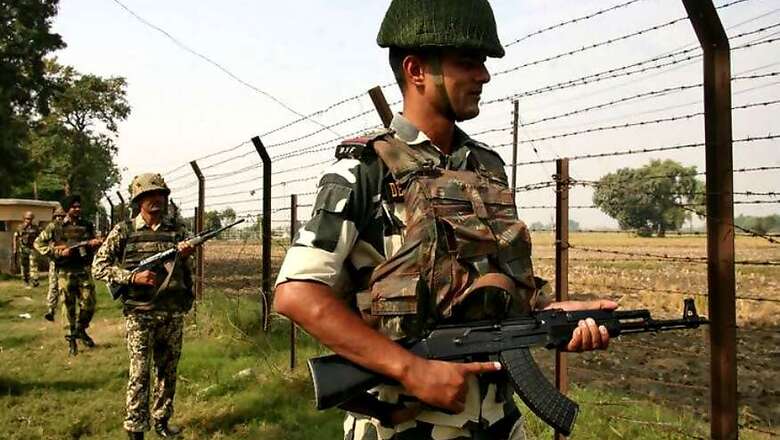
views
New Delhi: On December 19, the government informed the Lok Sabha that Pakistan had violated the ceasefire along the Line of Control (LoC) a total of 771 times — a 230% spike from 2016.
Counted with ceasefire violations along the International Border (IB), the total number of violations in Jammu and Kashmir stood at 881. Pakistan, too, hit back at India and claimed that India had violated the ceasefire agreement more than 1,300 times in 2017. So with ceasefire violations becoming the norm rather than the exception, is the 2003 agreement effectively dead?
Responding to Pakistan’s allegations of ceasefire violations, Army Chief General Bipin Rawat said India’s violations were only aimed at counter-terror operations and that the force struck Pakistani troops only when they were aiding and abetting terrorism.
Despite the grim picture of ceasefire violations in 2017, the Army Chief’s tone and tenor was positive. General Rawat said that the pressure on the Pakistani Army was working and the two nations may soon be able to return to more stable times.
“Our ceasefire violations are only in count-terror ops. But we saw that terrorists are a disposable commodity for Pakistan. Unless Pakistan Army faces pain, they will not stop infiltration. Even they will respond with violations. But I can assure you that their casualties are higher. If we see a drop in infiltration, we are willing to consider an absolute ceasefire and go back to the 2003 situation. The Army has been told to conduct operations in the manner we deem fit,” the Army Chief said on Friday.
He said Pakistan has been reaching out to India to negotiate a return to the 2003 situation. This, he said, was an indication that India’s tactic of putting pressure directly on the Pakistan Army was succeeding.
So where does that leave the ceasefire agreement of 2003, agreed upon by the governments of General Pervez Musharraf and prime minister Atal Bihari Vajpayee 15 years ago? Is it time to pronounce it dead? According to Lieutenant General (Retired) DS Hooda, who was the architect of India’s 2016 surgical strikes against terror launch pads in Pakistan-occupied Kashmir (PoK), the agreement “has been dead for a very long time”.
Interestingly, however, the agreement was never a formally written, signed one. “Prior to 2003, the situation along the LoC and the IB was pretty bad. When the agreement was made in 2003, it was never really put down on paper. As I understand, it was a verbal agreement between the two sides. Pakistan was the one to initiate the ceasefire by asking for it and we agreed to it,” Lt. Gen. (Retd) Hooda said.
For the first 10 years of the agreement, there was relative peace and calm along the LoC. “From 2003 to 2012, no major incidents took place along the LoC. We only reported some minor incidents. For example, one of the provisions of the ceasefire agreement was that no new posts would be constructed within a 500-meter radius of the line. Sometimes, when we would see them strengthening their defences or they would see us doing the same, there would be some warning shots fired. Now, technically, even a single round fired is a ceasefire violation. So they are counted as violations. But apart from minor incidents, nothing major happened there for the first 10 years.”
Then came January 8, 2013. India alleged that a Pakistani Border Action Team (BAT) had crossed over into India, ambushed an Indian Army patrol and killed two soldiers. One of the two soldiers who died was beheaded, which sparked outrage across India. Pakistan flatly denied the claim. A livid Salman Khurshid, the then Minister for External Affairs, vowed India would respond with a “proportionate” response.
Khurshid’s comments were followed by a series of border skirmishes between India and Pakistan, three in the month of January alone. That incident, said Hooda, changed the dynamic on the border and the LoC.
“In 2011, there were just 62 minor incidents of ceasefire violations. The number in 2012 was similar. In 2013, that number spiked to 347. Things were never the same after that. In 2013 alone, several major incidents were reported, including beheadings. Earlier, these violations were limited to warning shots. After 2013, the LoC saw a return of mortar shelling and rockets being launched,” Hooda said.
But is the Army Chief’s assessment that a return to the 2003 situation is within the realm of likelihood correct?
Yes, says Hooda, but with riders. “Two things need to happen. Before we go back to that situation, we will need to maintain sustained pressure on the Pakistan Army for some more time. Unless we hit them where it hurts, no strategy will succeed. Secondly, any new ceasefire agreement must be tied to some tangible reduction in infiltration and terrorism emanating from Pakistani soil. If both these things happen, I believe that a fresh ceasefire agreement is both likely and desirable. After all, the Indian Army doesn’t want any bloodshed. It is our boys who die at the LoC.”




















Comments
0 comment